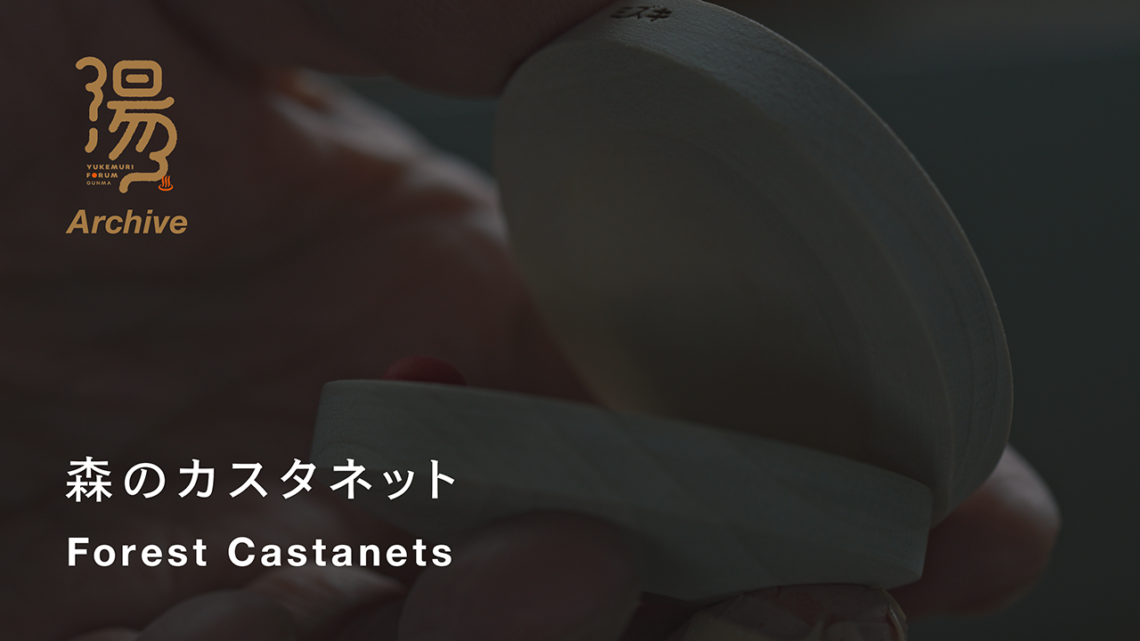- ARCHIVE
【湯けむりアーカイブス】日本のカスタネットづくりを支えてきた名工がつくる、森のカスタネット
シリーズ『湯けむりアーカイブス』では、群馬県内各地に根付く固有の文化や伝統、産業などを見つめ直し、地域の求心力であるその価値を丹念に紐解いて記録。未来へとつなげます。
ーーーーー
群馬県みなかみ町は、多くの人が小さな頃に慣れ親しんだ楽器・カスタネットの生産地。カスタネット工房(旧プラス白桜社)の二代目・冨澤健一さんは、手作りの機械と長年の経験でカスタネットづくりを支えてきた名工です。
赤と青のカラーリングが特徴的なカスタネットは全国に出荷され、最盛期には他工房の協力を得ながら、年間230万個を納品していたそうです。木を丸く貫く機械や窪みを加工する機械は冨澤さんが自作し、塗装方法や良い音を出すための研究も続けられてきました。
2013年には材料となる木材が手に入らなくなり、一旦生産を終了しましたが、地元地域の協力や自然保護協会からの声掛けもあり、子どもたちに森の木を教え・伝える「木育」としてカスタネットづくりは再開されました。
現在はヤマザクラやミズキ、クリといった日本の無垢木材を使用し「森のカスタネット」として広まっています。無塗装の木の質感を楽しめる楽器は手に馴染み、澄んだ森の音を響かせます。カスタネットづくりにおいて、板の選別や窪みの深さ、研磨の度合いはみなかみ町唯一の職人である冨澤さんの勘と経験によって仕上げられています。
「ワークショップでは子どもに好きな樹種を選んでもらい、絵を描いてもらうんですよ」
冨澤さんはこれからも、子どもたちの笑顔のためにカスタネットを作りたいと話してくれました。
<カスタネットづくりの工程>
1.板状にした木材を屋外に積み、乾燥。木は伐採したあとも呼吸をしているため、温度・湿度によって伸縮するという。
2.自作の機械でカスタネットサイズの丸型に木材を加工。節や木目が強い箇所を避けて貫く。
3.くり貫いた木材の断面が整っている方を上面とし、内側部分(凹み)を削る。音の反響を作る大切な工程。
4.外側部分を研磨し、手触りよく仕上げる。打ち合わせる方には軸を入れ、突起を作る。
5.樹種や柄を入れ、穴をあけてゴム紐を通したら完成。ゴム紐は二度縛り、指が通るように工夫されている。
Minakami in Gunma Prefecture is where castanets, musical instruments most Japanese use as children, are made. Keniichi Tomizawa is the second-generation owner of Castanet Workshop (formerly Plus Hakuosha). He is a master woodworker who makes castanets using hand-made machinery and knowhow based on many long years of experience.
Tomizawa’s castanets, with their characteristic red and blue colors, were shipped throughout the country. At its peak, Hakuosha—with the cooperation of many other workshops—was selling 2.3 million sets a year. Tomizawa made the machines that carved out the rounded form of the castanets as well as the machine that scooped out the hollow inside each piece. He researched the best way to paint the instruments and how to get the best sound out of them.
In 2013, it was no longer possible to get the lumber needed to make castanets, and production was halted. Then, at the encouragement of people in Minakami as well as the Nature Conservation Society, castanet production was revived as a way to teach schoolchildren about trees in the forests.
Today, Forest Castanets are made of natural wood from Japan: wild cherry, dogwood and chestnut. Users can enjoy the texture of the unfinished wood shaped to fit comfortably in the palm of the hand. The sound they make is reminiscent of an unspoiled forest.
Tomizawa, the only castanet craftsman in Minakami, makes all the decisions: what lumber to choose, how deep the hollows will be, and how finely the instrument should be polished.
“At workshops, I let children choose the type of wood they like and then have them paint a picture on the castanets”
said Tomizawa, as he spoke of his plans to continue making castanets for children to enjoy.
<How to make castanets>
1.Wood cut into boards is dried outdoors. Even after trees are cut down, wood continues to breathe, and it expands and contracts depending on the temperature.
2. A hand-made machine is used to process wood into the round shape of a castanet. Only wood free of knots and heavy grain is used.
3. The finished outer surface of the castanet is placed facing up, and the hollow in the middle is carved out. This process determines the sound the instrument makes.
4. The outside of the castanets are polished to a smooth texture. A shaft is inserted on one side to make the protuberance. 5. Castanets are then branded with a design and the type of tree they are made from. Finally, holes are drilled, and an elastic chord is threaded through them and knotted twice to make an opening just the right size to run fingers through.
映像制作:岡本 憲昭
インタビュー/解説:西 涼子
